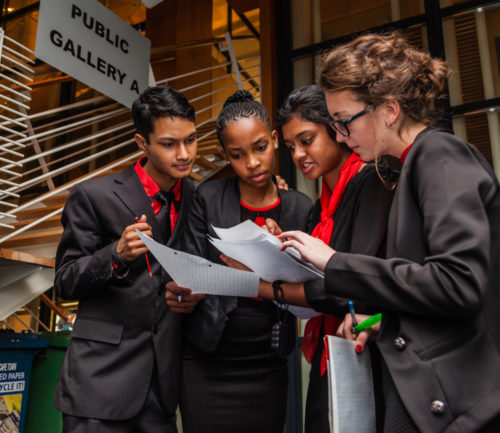
Delegates negotiating at the South African Model United Nations. Photo credit: UNIC Pretoria.
The Paris Climate Change Agreement in 2015 was groundbreaking because it was achieved with consensus. In the real United Nations is defined as the lack of objection by every Member State where a vote is not even necessary to adopt the resolution — was finally achieved after many rounds of climate change talks.
Consensus is important in real life UN agreements because Member States are more likely to implement the resolutions if they have no objections to them. In contrast, resolutions passed with simple majority votes are just going be ignored in real life if the Member State disagrees with them, so simple majority is actually weaker than consensus. Therefore, consensus is actually the default and preferred to voting procedures in the real UN.
Consensus may not be necessary in most Model UN conferences — most Model UN conferences require a simple majority vote for a resolution to pass, though UN4MUN conferences that emphasize accuracy such as the WFUNA International MUN aim toward adoption of resolutions by consensus instead of voting.
Nevertheless, attempting to reach consensus can help a delegate stand out as a leader. Strategically, it helps the resolution gain an overwhelming majority of committee support, which looks good to the Chair. Tactically, it helps build good faith and problem solving with the rest of the committee blocs, which is good for diplomacy and future relations (the future could be as soon as topic #2 in the committee!).
One negotiation technique to achieve consensus at the Paris Climate Change convention was called Indaba. Indaba is reportedly used by the Zulu and Xhosa people in South Africa to simplify negotiations. Per Quartz, indaba works like this:
“Instead of repeating stated positions, each party is encouraged to speak personally and state their “red lines,” which are thresholds that they don’t want to cross. But while telling others their hard limits, they are also asked to provide solutions to find a common ground.”
This could be done during unmoderated caucus with the resolution bloc standing in a circle. Instead of asking everyone what they want, suggest certain controversial ideas and ask who does NOT want that. This will immediately identify issues in the draft resolution that need to be worked out. This would be particularly effective to be used right before a draft resolution is to be submitted for presentation so that the group is fully aligned with the draft.
Similarly, indaba could be used when facilitating a merger between two groups. If two groups are merging, chances are that the majority of the two draft resolutions already have similar ideas or complementary clauses that are not controversial to everyone involved. Instead of focusing on those clauses, identify the clauses that the two blocs may disagree on, and then ask if it would be ok to remove or change any of those clauses. This is much more effective in identifying crux of the merger negotiation.
Lastly, indaba is not just identifying red lines or hard limits. It requires the group to also provide solutions to find common ground once they have identified those red lines. But having red lines makes it much more clear what countries want and do not want in a negotiation.


